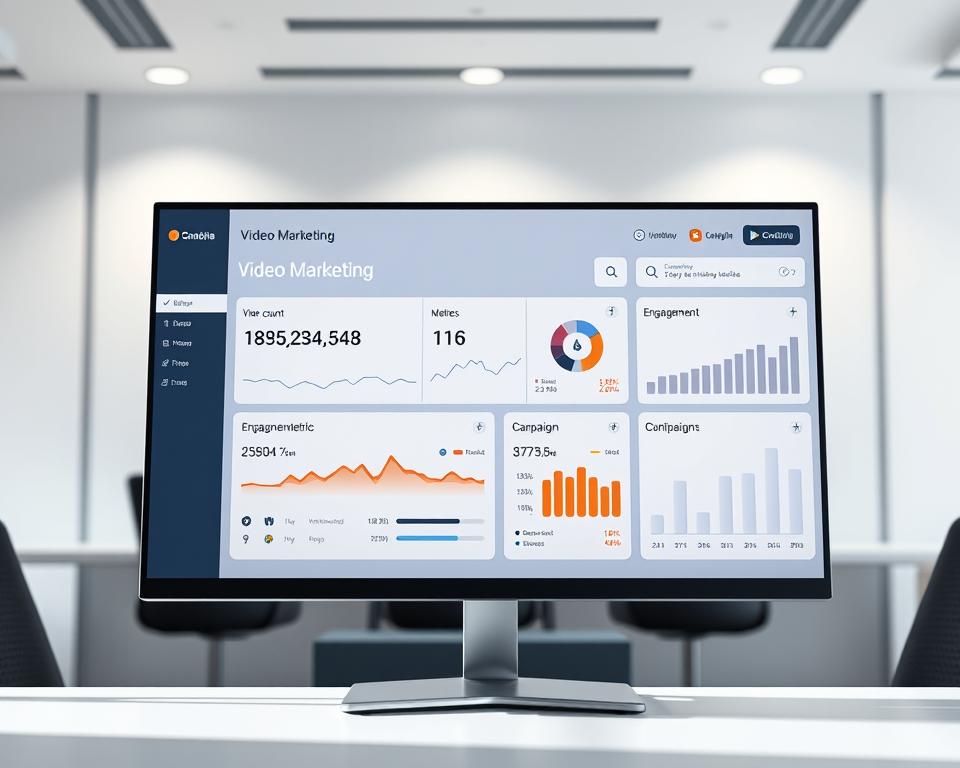
The Role of Video Production in Digital Marketing Strategies
Did you know 54% of consumers prefer video content from brands they support? In today’s fast-paced world, video production is key in digital marketing. It grabs attention through sight, sound, and story, unlike text alone. Red Bull’s Stratos Jump, for example, became a viral hit, showing video’s power to make brands famous.
In the UK, making videos is now essential for businesses. Videos help with SEO by keeping viewers watching longer, which search engines notice and reward. Over 83% of video marketers see more leads, and 44% of viewers are more likely to buy after watching. It’s not just about being creative; it’s a smart way to connect and succeed.
Key Takeaways
- 54% of consumers prioritise video content from brands they trust.
- Video content drives higher engagement and emotional connections compared to static media.
- Red Bull’s Stratos Jump campaign showcased viral success, reaching millions worldwide.
- SEO benefits include improved rankings due to increased watch times and reduced bounce rates.
- 83% of marketers use video to generate leads, with 44% of viewers more likely to buy after viewing.
Understanding Video Production in Digital Marketing
Video production is key in digital video marketing, helping brands stand out online. People love dynamic content, and videos tell stories better than text. They connect with audiences quickly.
Why Video Has Become Essential for Digital Marketers
Today, people want things fast and real. Video content creation meets this need by combining visuals and sound. Media Components uses top-notch editing to make videos that show what a brand is about.
These videos help build trust. In the UK, 44% of shoppers are more likely to buy after watching a product demo.
The Evolution of Digital Video Marketing
Marketing videos have changed from static ads to storytelling. TikTok and Instagram focus on short, fun videos. YouTube is for longer, detailed content.
UK companies like BrewDog use different strategies for each platform. This approach boosts brand recognition by 30%.

Key Statistics Supporting Video Marketing’s Effectiveness
- 83% of marketers say video campaigns bring in more leads.
- Videos get 3x more website engagement than text-only pages.
- Short ads on TikTok are 60% more memorable than regular ads.
“Videos aren’t optional—they’re the new standard for audience connection.”
These stats show why companies like Nationwide Building Society saw a 22% increase in applications. Video content is now a must for digital success.
The Psychology Behind Video Content’s Success
Video content works because it uses how our brains process information. We remember 65% more when we see and hear something compared to just reading. This makes video marketing campaigns very effective for brands. Videos that make us feel happy or inspired are shared 2.3 times more, helping them reach more people.

Stories are powerful. A story like the “Hero’s Journey” can make people more likely to buy by 80%. In the UK, 74% of people buy something after watching a helpful video. Trust and feeling like you can relate to the content are also key. Videos with real people talking about their experiences can make a brand 85% more believable.
| Statistic | Impact |
|---|---|
| 50% of consumers | More likely to choose a business after viewing a video |
| 22% higher memorability | For stories with emotional triggers |
| 60,000x faster | Visual processing speed vs. text |
Colours and movement grab our attention quickly. Adolfo Domínguez saw a 76% increase in people wanting to buy after using shoppable videos. Even adding captions can make people watch for 12% longer. Start with something interesting, like a question or a bold statement, to keep viewers watching.
For online video advertising, keeping it simple and emotional works best. Apple and Nike show how connecting with what people value can build strong bonds. Whether it’s a story or a how-to, the goal is to make viewers want to buy.
Types of Marketing Videos That Drive Results
Choosing the right video format can turn viewers into loyal customers. Video content creation thrives when tailored to your goals. Here’s how different types of videos boost engagement and conversions:

| Type | Purpose | Example |
|---|---|---|
| Explainer Videos | Showcase product benefits simply | Koala uses animations to clarify tech features |
| Brand Stories | Build emotional connections | Sealed blends live-action and cartoons to highlight values |
| Live Streaming | Engage in real time | Google’s interactive videos let viewers choose story paths |
| Tutorials | Teach while building authority | 91.9% of users watch how-to guides |
| Testimonials | Prove social proof | Case studies showing real-world results |
- Reebok’s silent video “25,915 Days” sparked 2 million shares by focusing on visuals over dialogue.
- Interactive videos increase click-through rates by 300%.
- 83% of UK shoppers use YouTube to research products before buying.
Successful video marketing strategy mixes these formats. For instance, Tesco’s “Voice of the Checkout” used customer voices to boost loyalty. Prioritize formats that match your brand voice and audience needs.
Creating a video marketing strategy
Creating a video marketing strategy means planning carefully. First, set clear goals like boosting engagement or sales. Over 90% of UK marketers say video helps generate leads. But, success comes from a good plan, not just creativity.

Defining Your Video Marketing Goals
- Set SMART goals: Specific, Measurable, Achievable, Relevant, Time-bound.
- Align with broader marketing aims, like boosting website traffic or brand awareness.
- Track metrics like view duration and conversion rates to evaluate progress.
Understanding Your Audience
Learn about your audience’s demographics, likes, and how they use platforms. For instance, TikTok fans might enjoy quick, fun videos. Use Google Analytics and social insights to find out when and what they like best.
Developing a Content Calendar
Plan out when to post videos. For example, a fitness brand might share workout videos weekly, matching health trends. Use Trello or Asana to keep track of your videos on YouTube, Instagram, and LinkedIn.
Budgeting for Video Production
Set aside money for video production in digital marketing. You can spend little on smartphone videos or more on studios. For big projects, consider UK agencies. For everyday content, your team can handle it. Aim to spend 20-40% of your marketing budget on making and sharing videos.
Essential Elements of High-Quality Video Production
Creating great video content is more than just an idea. It’s about combining technical and creative skills. This mix turns simple footage into a strong marketing tool. Here’s what makes the difference:
- Planning: Begin with a clear brief. Define your message, audience, and goals. A well-planned script and storyboard save time and resources.
- Technical Precision: Lighting and sound are key. Bad audio or harsh shadows can pull viewers away. Good visuals and clear audio build trust.
- Storytelling: Connect with viewers through stories. Whether it’s a product or a brand story, being real works best.
- Edit with Purpose: Post-production makes raw clips into a story. Editing software, transitions, and colour grading polish the final product.
Choosing the right video production services ensures these elements work well together. A skilled video production company in the UK can manage everything from start to finish. For example, lighting and sound design are key. They show how professional your brand is.

Did you know 83% of marketers say video has the highest ROI? But quality is key. Low-budget videos are easy to spot. Invest in video production services for big projects like product demos or brand films. For simpler stuff, your in-house team can do great with some guidance.
Even small things like subtitles or background music count. They make good videos unforgettable. Focus on these elements to boost your digital marketing.
How to Choose the Right Video Production Company in the UK
Finding the right video production company is key to your campaign’s success. First, define your project’s scope and budget. This helps narrow down your choices. Look for companies that match your brand’s voice and technical needs.

Questions to Ask Before Hiring a Video Production Service
Here are important questions to ask:
- What’s your portfolio? Look for work that fits your industry and style.
- Do you handle all phases—from scripting to distribution?
- How do you handle revisions and deadlines?
- What’s your process for approving edits and finalising content?
In-House vs. Outsourced Video Production
Consider these options:
- In-House: Great for small, repetitive projects. You need to hire staff and buy equipment.
- Outsourced: Best for complex campaigns. It offers flexibility and expertise without long-term commitments.
Cost Considerations for Professional Video Services
Contracts often ask for a 50% deposit upfront. The rest is paid when the video is delivered. Be clear about:
- Ownership transfers only after full payment.
- Budget for extra days or post-production edits.
- Contract terms for equipment, rights, and deadlines.
Ask for detailed quotes to avoid surprises. Compare prices from 3-5 providers to find the best value.
Optimising Videos for Different Digital Marketing Channels
To make your video marketing campaign work best, know how each platform’s audience likes to watch videos. Whether it’s Instagram’s fast scrolls or LinkedIn’s professional content, adjust your video’s style, length, and message. This way, your online video advertising will surely connect with your audience.

- Platform-Specific Requirements: YouTube loves vertical videos (9:16 aspect ratio) for mobile users. LinkedIn is all about short, polished clips under 2 minutes. TikTok’s algorithm prefers 15-60 second videos with text overlays, while Facebook likes 1:1 square videos for feeds.
- Social Media Tailoring: Instagram Stories need bold text and swipe-up links. Twitter pairs video snippets with trending hashtags. LinkedIn audiences enjoy data-driven content, while TikTok’s Gen-Z crowd loves authenticity and humor.
- SEO Best Practices: Use keywords in video titles (under 55 characters), descriptions (200 characters max), and closed captions. Video sitemaps and transcripts help with search visibility. Add CTAs in video descriptions and link to landing pages for conversions.
Google Analytics and YouTube Studio track important metrics like watch time and click-through rates. Test different thumbnails and CTAs to improve your strategy. Remember, 82% of internet traffic is from video. So, matching your content with each platform’s style can turn viewers into loyal followers.
Measuring the Success of Your Video Marketing Campaign
Tracking the right metrics is key to success. A video marketing campaign’s success isn’t just about views. It’s about moving audiences closer to your goals. Let’s explore how to analyse performance without getting overwhelmed.

- Focus on actionable KPIs: Watch time, conversion rates, and ROI are more important than just views. A 97% rise in purchase intent for product videos shows engagement boosts sales.
- Compare to industry benchmarks: With 91% of UK businesses using video marketing, knowing average performance helps spot opportunities. Aim to outperform the 90% of companies reporting strong ROI.
- Use built-in tools: YouTube Analytics and Facebook Insights track shares, click-through rates, and audience demographics. Pair these with Google Analytics to see full customer journeys.
- Test and iterate: A/B test thumbnails, CTAs, and video lengths. Small changes can boost engagement by up to 30%.
Qualitative feedback is important too. Positive comments on social media or high retention in the first 10 seconds show a compelling video marketing strategy. Tools like Hotjar can show where viewers drop off, guiding edits to keep attention.
Start by linking every video’s goals to business outcomes. If a campaign aims to drive sign-ups, track form submissions after views. Regularly review data to tweak future content, ensuring your strategy stays sharp and ROI grows.
Current Video Marketing Trends Transforming the Industry
Video marketing trends in 2024 are changing how brands talk to their audience. Vertical formats, AI-driven personalization, and immersive tech are leading the charge. Businesses need to keep up to stay ahead in digital video marketing.

“Vertical video content results in a 130% higher engagement rate compared to horizontal videos.” – Statista 2023
The Rise of Vertical Video Format
Vertical videos are big on mobile platforms. TikTok and Instagram Reels are all about short, vertical clips. Brands like Starbucks grab attention fast with vertical content, tapping into users’ love for scrolling.
Creating content for vertical screens boosts visibility on platforms where 86% of businesses see sales go up.
AI and Personalised Video Experiences
Artificial intelligence now makes content fit individual tastes. Tools like Wibbit and Lumen5 use AI to craft custom video scripts or dynamic ads. Over 73% of businesses see better engagement with AI-personalized content, showing its value.
Marketers can now create ads that really speak to people, without needing to edit them by hand.
Shoppable Video Content
Shoppable videos blend shopping with fun. TikTok’s deals with Shopify let viewers buy products straight from videos, boosting conversion rates by up to 30%. Brands like ASos turn viewers into buyers easily, making ads both fun and functional.
Virtual and Augmented Reality Applications
Augmented reality (AR) and VR offer deep dives into experiences. IKEA’s AR app lets you see furniture in your home, while Nike’s VR campaigns let you try on shoes virtually. Though it takes investment, the AR/VR market is growing fast, expected to hit $62 billion by 2029.
Common Pitfalls in Video Content Creation and How to Avoid Them
Creating successful video content means avoiding common mistakes. Many businesses miss out on simple steps, leading to lost chances. Here are tips to avoid these errors:
- Unclear messaging: Videos without a clear goal fail to engage. Define your objectives, whether it’s brand awareness or sales, right from the start.
- Poor audio or visuals: Shaky footage or background noise can be distracting. Ensure good lighting, use quality microphones, and consider working with local UK production teams for better results.
- No call to action: Viewers need to know what to do next. Always end your video with a clear instruction, like “visit our website” or “download our guide”.
- Ignoring platform rules: Different platforms have their own preferences. For example, Instagram likes vertical videos, while YouTube is better for longer content. Make sure to tailor your format to each platform.
- Overlooking SEO: Include keywords in your titles, descriptions, and tags. Use tools like Google Keyword Planner to find popular search terms.
Regularly check your analytics to see how your videos are doing. Tools like YouTube Analytics or social media insights can show which videos are most engaging. For example, a 2023 study by Wyzowl found that 85% of viewers remember more from videos than text, if the content meets their needs.
Start small, even with short 30-second clips. Focus on one main message. Viewers want clarity, not perfection. Working with UK agencies, like those in London, can help keep your brand goals in mind without overspending. The key is to find a balance between creativity and strategy, turning possible pitfalls into chances for growth.
Case Studies: Successful Video Marketing Campaigns from UK Brands
See how UK brands used video marketing to get real results. These stories show how creativity meets data:
| Brand | Challenge | Strategy | Result |
|---|---|---|---|
| Yorkshire Tea | Boost brand engagement | Collaborateded with a video marketing agency to produce relatable travel-themed videos | 27% of vacation planners linked to choosing the brand |
| Monzo | Raise brand visibility | Data-driven video marketing campaign targeting local audiences | 38% of users discovered Monzo via billboards—20% higher than average |
| Netflix | Stand out in a crowded market | Personalized content aligned with UK preferences for customization | 31% of viewers valued tailored options |
What Made These Campaigns Effective
Authenticity was key for success. Yorkshire Tea’s “Pack yer bags” videos were funny and local. Monzo used billboards, a hit with 38% of users. Netflix matched UK viewers’ love for personalization.
Lessons Learned from Top-Performing Video Content
- Collaborate with a skilled video marketing agency to craft targeted narratives.
- Embed data into every stage of the video marketing campaign, from ideation to distribution.
- Use relatable storytelling to build trust and recognition.
These stories prove the power of custom video plans. By following these tips, businesses can connect with UK viewers.
Conclusion: Integrating Video Production into Your Digital Marketing Strategy
Video production is key in today’s digital world. It boosts conversion rates by 80% on landing pages and 74% after watching ‘how-to’ content. YouTube, with over one billion users, is a huge platform for reach.
Social media also favours video over static posts. As trends evolve, like interactive live streams or shoppable content, businesses must keep up to stay ahead.
Deciding between an in-house team or a video marketing agency depends on your resources. Agencies like VINDICTA offer expertise and ensure projects meet copyright guidelines and timelines. They have a clear process, including a 50% deposit upfront and delivery terms to avoid delays.
New brands can start with short tutorials or testimonials. Established firms can explore advanced formats like 360-degree videos or AR integrations.
Stay on top of video marketing trends by focusing on mobile-friendly formats and SEO-optimised content. Update your strategies to match algorithm changes and audience preferences. Video is vital for boosting engagement and reducing bounce rates.
Begin by setting clear goals, test different formats, and measure results. This will help you refine your approach over time.